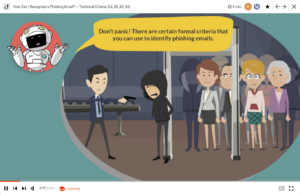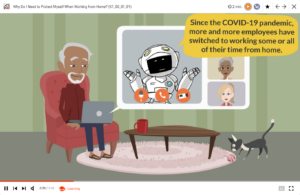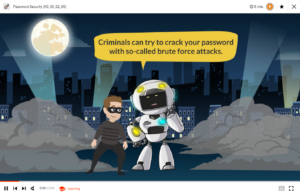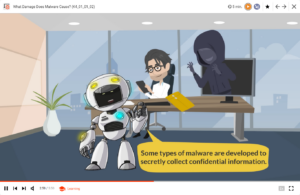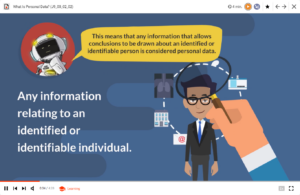soluzione42 E-learning Courses
![]() Our platform is always up to date, so your employees are prepared for future threats. Our animated training films are not only entertaining, but also designed with learning psychology in mind. With motivational storytelling, best practices, and relevant takeaways, the films are:
Our platform is always up to date, so your employees are prepared for future threats. Our animated training films are not only entertaining, but also designed with learning psychology in mind. With motivational storytelling, best practices, and relevant takeaways, the films are:
- Easy to implement in the workplace
- Generate high levels of employee buy-in
- Helps build sustainable habits
Our e-learning security content is integrated with our learning platform. Courses such as Phishing, Security in the Office and in Your Remote Office, Secure Passwords & MFA, Data Protection and Malware provide your employees with the necessary and up-to-date knowledge. In addition, we are constantly adding new modules to our portfolio.
Descriptions of the individual course modules:
This course explains exactly how to recognize phishing emails or fake login pages using current examples. We give you tips on how to protect yourself and show you what to do if you have already responded to a phishing email.
Course chapter outline:
In our course you will learn everything you need to know about „Phishing & IT Security“ in ten compact learning modules (total duration: 38 minutes).
- What Is Phishing?
- How Dangerous Are Phishing Emails?
- How Can I Recognize a Phishing Email? – Formal Criteria
- How Can I Recognize a Phishing Email? – Linguistic Criteria
- How Can I Recognize a Phishing Email? – Social Engineering
- How Do I Recognize a Fake Login Page?
- What Shall I Do if I Opened a Phishing Email or Reacted to One?
- How Can I Protect Myself?
- What Is Spear Phishing?
- What Is Quishing?
When you work in an office-whether it’s an open-plan office or a single room-it’s easy to overlook the vulnerabilities that can give unauthorized people access to sensitive data. And even when working from home, there are risks associated with sharing rooms or using personal devices. In this course, you will learn exactly how to protect your workplace using technology and your own common sense. We offer tips on how to identify threats and what to do if you suspect a malware attack. We also provide information on how to conduct online meetings and work remotely.
In our course, you will learn everything you need to know about „Office Workstation, Home Office and IT Security“ in nine compact learning modules (total duration: 36 minutes).
Course chapter outline:
- Safety at the office
- Why Do I Need to Protect Myself When Working from Home?
- How Can I Protect My Workspace
- How Can I Protect My Devices?
- How Can I Protect Myself and Others During Meetings?
- How Can I Make Teams Meetings More Secure?
- How Can I Recognize Threats to My Device?
- What Should I Do About Acute Threats?
- How Can I Protect Myself When Mobile Working?
By popular demand, we have already created an in-depth e-learning video on password security. In it, we outline known password hacking techniques and provide concrete help on how to create strong yet memorable passwords. We also cover password recovery and the do’s and don’ts of password storage (total duration: 16 minutes). The course also covers multi-factor authentication. You will learn what authentication methods exist and how hackers make use of them.
Course chapter outline:
- Password Security
- Multi-Factor Authentication (MFA)
- MFA Bombing
Malware generally refers to any type of malicious software. It is designed to damage or manipulate computers, networks, and data. This course explains exactly what forms malware can take, how it gets on your device, and what damage it can do. You will also get valuable tips on how to recognize signs of malware and what to do if you suspect malware on your device.
In our course, you will learn everything you need to know about „What is Malware and how to deal with it“ in 15 compact learning modules (total duration: 62 minutes).
Course chapter outline:
- What Is Malware?
- What Damage Does Malware Cause?
- How Does Malware Get on My Device?
- What Is a Virus?
- What Is a Worm?
- What Is a Trojan?
- What Is Ransomware?
- What Is Spyware?
- What Are PUPs and Adware?
- What Do I Do About Malware on My Device?
- Can I Be a Victim of Malware?
- How Can I Recognize Phishing Emails? – Formal Criteria
- How Can I Recognize Phishing Emails? – Linguistic Criteria
- How Can I Recognize Phishing Emails? – Social Engineering
- Password Security
The important and complex issue of privacy is how to protect personal information from unauthorized access, misuse, or loss. In this course, you will learn about the legal requirements for data protection, the obligations you have when handling personal data, and who is liable in the event of a data breach. We distinguish between data privacy and data security, and provide illustrative examples of how to deal with service providers, personal data, or the use of data for advertising purposes. Finally, we look at the role of the data protection officer and explain how data protection is organized in companies.
Our course teaches you everything you need to know about protecting personal information in 26 compact learning modules (total duration: 75 minutes).
Course chapter overview:
- Introduction: Data Protection
- What Is Data Protection?
- What Is Personal Data?
- Differences to Data Security
- Legal Guidelines:
- The General Limitation Principle and the Exceptions
- Consent
- Authorization to Enter Contracts
- Who Is Liable?
- Obligation to Accompany:
- Intro
- Duty to Provide Information About Data Protection
- Obligation to Delete
- Procedure Index
- Involvement of Service Providers Who Process Data
- Handling Personnel Data:
- Intro
- Avoid Consent
- Use DSGVO
- Comprehensive Data Protection Information
- Delete Data
- Regulate HR Data Transfers
- Commitment to Confidentiality Declaration
- Sensitive, Performance, Conduct-Related Data
- Data Protection at Work
- The Role of the Data Protection Officer
- Commercial Use of Data:
- Data Protection Law and Advertising
- Competition Law
- Follow-Up Questions and Common Scenarios

